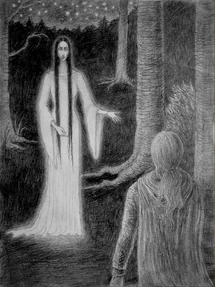Bitterhand (talk | contribs) No edit summary Tag: Visual edit |
Weas-El-Bot (talk | contribs) m (Bot: Adding nl:Thingol) |
||
| Line 186: | Line 186: | ||
== References == |
== References == |
||
| − | <references />[[ |
+ | <references />[[Category:Teleri]] |
| ⚫ | |||
| ⚫ | |||
| ⚫ | |||
| ⚫ | |||
| ⚫ | |||
| ⚫ | |||
| ⚫ | |||
| − | |||
| − | [[Category:Teleri]] |
||
[[Category:High Elves]] |
[[Category:High Elves]] |
||
[[Category:Grey Elves]] |
[[Category:Grey Elves]] |
||
| Line 204: | Line 195: | ||
[[Category:Characters in The Children of Húrin]] |
[[Category:Characters in The Children of Húrin]] |
||
[[Category:Characters in The History of Middle-earth]] |
[[Category:Characters in The History of Middle-earth]] |
||
| + | |||
| + | [[ca:Thíngol]] |
||
| ⚫ | |||
| ⚫ | |||
| ⚫ | |||
| ⚫ | |||
| + | [[nl:Thingol]] |
||
| ⚫ | |||
| ⚫ | |||
| ⚫ | |||
Revision as of 16:51, 29 December 2019
Elu Thingol was an Elf of the Teleri during the First Age. His brother was Olwë, who became the Lord of Alqualondë, Lord of Tol Eressëa, and High King of the Teleri of Aman, both of whom may have had a second brother called Elmo. He was a good friend of Finwë, the first High King of the Ñoldor during the times before the elves reached Aman.
He was the founder and first King of the northern Elven Kingdom of Doriath and was respected by all the Sindar of the Beleriand, who considered him to be the High King of the Sindar and the Lord of Beleriand.
Biography
Sundering of the Elves

Finwë and Elwë in Cuiviénen before the Great Journey to Aman, by Kazuki-Mendou
Elwë was born in Cuiviénen during the Years of the Trees to unnamed parents. He first appears in the history of the Eldar when he travels from Cuiviénen with Oromë as ambassador of the Teleri to see the land of Valinor. Interestingly, since Thingol had previously visited Valinor as an ambassador of the Teleri, he is debateably both of the Sindar and of the Calaquendi. Upon his return, he manages to convince many of his people to follow him back to that country. On the Great Journey to the West, the Teleri lag behind, and do not arrive at the coast until after the departure of the moving island of Tol Eressëa. Thus, they stay in Beleriand for many years until Tol Eressëa is brought again to fetch them. By this time, many of the Teleri have grown to like Beleriand, and decide to stay there. Elwë is among them, having encountered Melian the Maia in the woods of Nan Elmoth and fallen deeply in love with her. Afterwards, he disappeared for many years causing many of his people to linger in Middle-earth or stay there until he could be found.[3]

Elwë is enchanted by Melian in the woods of Nan Elmoth, by WilderWein77 now IreneLangholm
Rule of Doriath
For centuries Elwë remained lost until he reemerged as a respected lord and many of his people joined him in the great forested area of the Beleriand. Now known as Thingol, he and Melian become king and queen of the Teleri who stay in Beleriand, who then become known as the Sindar. He founded a realm in a large forested area in the Beleriand first known as Eglador (Land of the Forsaken). During these early days under the stars, Thingol and Melian have a daughter named Lúthien, who is said to be the fairest woman ever to have lived.
As Lord of Beleriand, he welcomed his long lost kin now known as the Laiquendi or Green-elves vast lands in Ossiriand which they would name Lindon. He was also the first elf to make contact and alliances with the Dwarves of Belegost who helped delve the caves of the great Fortress/City of Menegroth which became the capital of Thingol's kingdom. When the Dwarves first became aware of unknown but savage creatures coming from out of the North, Thingol was the first to know about it and not having any heavy weapons of war he once again asked the Dwarves for their aid. They forged for him weapons and armour he needed to fight them.[4]
The Quest for the Silmaril
When Melkor returned to Middle-earth, he sought once again to master Middle-earth and its peoples and declared war on them. He sent his great hosts of Orcs into the Beleriand starting what became known as the First Battle of Beleriand. Thingol led his people to victory against the Orcs successfully driving them out of his kingdom and most of the Beleriand. Afterwards, Melian set the Girdle around his kingdom which would be known from then on as Doriath which no one could enter without his permission. When the Ñoldor returned to Middle-earth, he gave them leave to dwell in the north part and dealt only with the House of Finarfin as they were kin through his brother Olwë. When he learned of the Kinslaying at Alqualondë, he was outraged and wanted nothing to do with most of the Ñoldor and their war and even outlawed the use of Quenya in his kingdom.[5]
Thingol was drawn into the war with Morgoth and the deadly Oath of Fëanor when after the Dagor Bragollach, Lúthien fell in love with a man named Beren. Thingol did not wish for the two to be wedded to each other, as he valued his daughter very highly and disliked the race of Men. As a bride-price he asked for a Silmaril from the crown of Morgoth, thinking there was no way that Beren could fulfill this demand. Thus, Thingol was drawn into the quarrels over the great jewels and ultimately the doom of Fëanor.[6]
Death
It was, however, this very bride-price that doomed him. After Húrin brought the treasures of Nargothrond to Doriath, Thingol summoned Dwarves of Belegost to Menegroth and invited them to work the treasure into jewelry. The finest of these pieces was the Nauglamír.
The Nauglamír was the second-greatest treasure of Doriath, prized above all but Beren and Lúthien's Silmaril. After the smiths of Belegost finished their work on the Nauglamír, Thingol requested that the Dwarves of Nogrod set the Silmaril in it. The Nauglamír, now bearing the Silmaril was held to be the fairest object in Arda.
Enthralled by its beauty and greedy for the Silmaril, the Dwarves demanded the necklace insisting that as dwarf work it belonged to them. Thingol was unwilling to surrender the treasure and replies with an impertinent answer. In their anger, the Dwarves attempted to slay him. After a long battle between Dwarves and elves inside the city, Dwarves were driven out of the city, two escaped to Nogrod and persuaded the city to march on Doriath. They escaped and told a much different story to their home cities and got them to march on and sack Doriath. Later with the help of certain treacherous elves also possessed of the cursed treasure they regained entrance past the Girdle. Thingol was lured out on a hunt with but a small company of arms, where he was ambushed by waiting Dwarves, and was slain. The fortress of the Thousand Caves was taken at unawares and plundered. They could not seize nor harm Melian, and she left to seek Beren and Lúthien.[7]
Thingol's heir was Dior Eluchil, the son of Beren and Lúthien.[8]
Etymology
Elu Thingol derives from the Sindarin Elu Sindacollo, meaning "Elu Greycloak", from thind or sinda ("grey") and collo ("cloak").[9]
The original form of his name was Elwë Singollo from the Quenya el ("star") and wë ("person").[10]
Weapons
Thingol's sword was called Aranrúth ("King's Ire") which later became the sword of the Númenórean kings.[11] He also owned Anglachel, the sword forged by Eöl who gave it to him as payment for dwelling in Nan Elmoth.[12]
House of Thingol
|
| Thingol |
| Melian |
| |||||||||||||||||||||||||||||||||||||||||||||||||||||||||||||||||||||||||||||||||||||
|
|
|
|
|
| |||||||||||||||||||||||||||||||||||||||||||||||||||||||||||||||||||||||||||||||||||||
|
|
|
| Lúthien |
| Beren | ||||||||||||||||||||||||||||||||||||||||||||||||||||||||||||||||||||||||||||||||||||
|
|
|
|
|
|
|
| |||||||||||||||||||||||||||||||||||||||||||||||||||||||||||||||||||||||||||||||||||
|
|
|
|
|
| Dior |
|
|
| Nimloth | ||||||||||||||||||||||||||||||||||||||||||||||||||||||||||||||||||||||||||||||||
|
|
|
|
|
|
|
|
|
|
|
|
|
| |||||||||||||||||||||||||||||||||||||||||||||||||||||||||||||||||||||||||||||
|
|
|
|
|
| Eluréd and Elurín |
|
|
| Elwing |
| Eärendil | ||||||||||||||||||||||||||||||||||||||||||||||||||||||||||||||||||||||||||||||
|
|
|
|
|
|
|
|
|
|
|
|
|
|
|
|
|
|
| ||||||||||||||||||||||||||||||||||||||||||||||||||||||||||||||||||||||||
|
|
|
|
|
|
|
|
|
|
| Elros |
|
| Elrond | ||||||||||||||||||||||||||||||||||||||||||||||||||||||||||||||||||||||||||||
Behind the scenes
Thingol underwent quite a bit of developmental changes. In some of the earlier writings, and in particular the drafts for The Hobbit, Thingol was said to be the leader of the Dark Elves, and was a Dark Elf himself. This note of him being referred to as the Dark Elf as one of his nicknames/titles/insults is still seen in the published Silmarillion: "...this Dark Elf in his caves!"
Translations
| Foreign Language | Translated name |
| Arabic | ثينجول |
| Armenian | Թինգոլ |
| Belarusian Cyrillic | Тінгол |
| Bengali | থিঙ্গল |
| Bulgarian Cyrillic | Тингол |
| Catalan | Thíngol |
| Chinese (Hong Kong) | 辛葛 (Thingol)
埃盧·庭葛 (Elu Thingol) 埃爾威 (Elwë) |
| Georgian | თჰინგოლ |
| Greek | Θίνγκολ |
| Gujarati | થિંગોલ |
| Hebrew | תינגול (Thingol)
אלו תינגול (Elu Thingol) אלווה (Elwë) |
| Japanese | シンゴル (Thingol)
エルウェ (Elwë) エル・シンゴル (Elu Thingol) |
| Kannada | ಥಿಂಗಲ್ |
| Kazakh | Тһінгол (Cyrillic) Thingol (Latin) |
| Korean | 싱골 |
| Kyrgyz Cyrillic | Тhингол |
| Macedonian Cyrillic | Тингол |
| Marathi | थिंगोल |
| Mongolian Cyrillic | Тингол |
| Persian | تینگول (Thingol)
الوه (Elwë) |
| Russian | Тингол (Thingol)
Элу Тингол (Elu Thingol) Эльвэ (Elwë) |
| Serbian | Тингол (Cyrillic) Thingol (Latin)
Елу Тингол (Cyrillic) Elu Thingol (Latin) |
| Tajik Cyrillic | Тҳингол |
| Tamil | திண்கொள் |
| Telugu | తింగోల్ |
| Thai | ธิงโกล |
| Urdu | تانگاول |
| Uzbek | Тҳингол (Cyrillic) Thingol (Latin) |
| Yiddish | טהינגאָל |
| King of Doriath | ||
| Preceded by None |
Thingol | Succeeded by Dior Eluchíl |
| YT ? - FA 502 | ||
References
- ↑ 1.0 1.1 The History of Middle-earth, Vol. X: Morgoth's Ring, The Annals of Aman, third section
- ↑ 2.0 2.1 The History of Middle-earth, Vol. X: Morgoth's Ring, The Later Quenta Silmarillion, The First Phase, "Of the Coming of the Elves"
- ↑ The Silmarillion, Quenta Silmarillion, Chapter III: "Of the Coming of the Elves and the Captivity of Melkor"
- ↑ The Silmarillion, Quenta Silmarillion, Chapter V: "Of Eldamar and the Princes of the Eldalië"
- ↑ The Silmarillion, Quenta Silmarillion, Chapter XIII: "Of the Return of the Ñoldor"
- ↑ The Silmarillion, Quenta Silmarillion, Chapter XIX: "Of Beren and Lúthien"
- ↑ Beren and Lúthien
- ↑ The Silmarillion, Quenta Silmarillion, Chapter XXII: "Of the Ruin of Doriath"
- ↑ The Silmarillion, Appendix: Elements in Quenya and Sindarin names
- ↑ The History of Middle-earth, Vol. V: The Lost Road and Other Writings, Part Three: "The Etymologies"
- ↑ Unfinished Tales, Introduction, Part Two, I: "A Description of the Island of Númenor", Notes
- ↑ The Silmarillion, Quenta Silmarillion, Chapter XXI: "Of Túrin Turambar"

